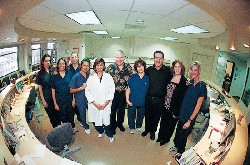Have you heard this one? A doctor and a lawyer were at a cocktail party. A woman came up to the doctor and asked for medical advice.

Office manager Janie Neville and optometrist Robert Buffington quit doing human resources tasks. Instead, they hired an outside professional employer organization. Photo: Beth Baugher.
The doctor mumbled some suggestions, then turned to the lawyer and asked, What do you do when youre asked for advice at a social function?
Whenever you hand out advice, send out a bill, replied the lawyer.
The next morning, the doctor went to his office and wrote up a bill for $50 for the woman.
That afternoon, the doctor received a bill for $100 from the lawyer.
Just goes to show that doctors arent always so business savvy.
Thats okay. While optometrists need to keep an eye on the bottom line, we shouldnt be distracted by every practice management issue. And perhaps our biggest issue these days is taking good care of our staffincluding offering employee health insurance.
It was a problem 25 years ago, too. Thats when our lawyer gave us some very good advice: Outsource human resources with a professional employer organization (PEO). His firm, which included some two dozen attorneys, used a PEO to manage their human resources.
Even if our lawyer had charged us for his advice, it would have been worth it many times over. Using a PEO has really paid off.
The primary benefit we were looking at back then was finding a discount on health insurance. Our practices philosophy was (and still is) that if you want to hold on to your employees, then you should pay 100% of their health plan. At the time, we had six employees, with one full-time and one part-time doctor. Now we have ten employees and three doctors, and we still provide 100% of our employees health insurance.
The only way we can do it is with the help of a PEO. Professional employer organizationsbecause they represent employees from many different small businesseshave the buying power to make health-care insurance affordable for a medium-size practice such as ours.
What is a PEO?
A professional employer organization is like having a human resources person on staff but off-site.
Our PEO handles payroll administration and tax reporting. It provides benefit packages, manages employee files, and handles COBRA. It administers 401(k), long-term leave and workers compensation, and provides employee policy manuals. It helps us throughout the whole process of hiring a new employee and, if need be, helps us in disciplining or firing an employee.
Of course, one of the most important benefits for us is that the PEO enables us to offer very good health insurance coverage plans to our employees at competitive rates. Its difficult for any small employer to offer full coverage, but our PEO gives our employees several choices, including a PPO and two HMOs, as well as a dental plan and life insurance.

By hiring a PEO to take care of human resources, Buffington Eyecare saves the expense of at least one staffperson, and gets a better deal on health insurance.
We would never be able to offer these kinds of benefits on our own. (According to a report from the Kaiser Family Foundation, employer-sponsored health insurance premiums rose 14% between 2002 and 2003, the third consecutive year of double-digit increases and the highest premium increase since 1990.)
But a PEO can offer this kind of coverage because it represents thousands of employees from many different businesses. So it has the clout to negotiate discounts on medical benefits and other perks. We believe this incentive has helped us reduce turnover in our office, and gives us that something extra that prospective employees are looking for.
Other PEO Perks How to Choose a Professional Employer Organization (PEO)
Not all PEOs are the same, of course. (See How to Choose a PEO, below.) Some are smaller and more personalized, some are larger and offer more choices. All handle payroll and health benefits, though some PEOs also offer specialized options, such as employee wellness programs, adoption assistance, scholarship programs, and even discounts on movie tickets, vacations and restaurants.
Our PEO administers paychecks via direct deposita reliable and expedient method of payment that our employees really appreciate. The PEO also offers other banking as well as loan services.
The National Association of Professional Employer Organizations offers the following guidelines to companies considering a relationship with a PEO:
1. Assess your workplace to determine your human resource and risk management needs.
2. Make sure the PEO is capable of meeting your goals. Sales brochures and fancy proposals are easy to print. Meet the people who will be serving you.
3. Check the firm"s financial background. Ask for banking and credit references. Ask the PEO to demonstrate that payroll taxes and insurance premiums have been paid.
4. Ask for client and professional references.
5. Check to see if the company is a member of NAPEO, the national trade association of the PEO industry (www.napeo.org).
6. Investigate the company"s administrative and risk management service competence. What experience and depth does their internal staff have? Do any of the senior staff have professional training or designations?
7. Understand how the employee benefits are funded, are they fully insured or partially self-funded? Who is the third-party administrator (TPA) or carrier? If required in your state, is their TPA or carrier licensed?
8. Understand how the employee benefits are tailored.
Determine if they fit the needs of your employees.
9. Review the service agreement carefully. Are the respective parties" responsibilities and liabilities clearly laid out? What guarantees are provided? What provisions permit you or the PEO to cancel the terms of the contract?
10. If your state requires a PEO to be licensed, certified or registered, make sure that the company you are considering meets all such requirements. A majority of states have some form of regulatory requirement. Arkansas, Florida, Illinois, Kentucky, Louisiana, Maine, Minnesota, Montana, Nevada, New Hampshire, New Jersey, New Mexico, New York, North Carolina, Oklahoma, Oregon, South Carolina, Tennessee, Texas, Utah, Vermont, Virginia and Washington all have some form of licensing or registration requirements. A number of other states have certain certification or regulatory requirements for PEOs as well.
As a responsible employer, we appreciate another important job that a PEO does: keeping compliant with state and federal employment requirements. This is a big issue here in California. The rules for employers are complex and strict, and navigating them is difficult to do on your own. Our PEO keeps up with the latest rules and requirements, and advises us accordingly.
A PEO can help with unusual or sticky employee situations. What if you have an employee who goes on maternity leave, but changes her mind about returning to her job? What if you have an employee who suddenly resigns, and you dont know where you stand on his remaining earnings? One call to the PEO tells us what our responsibilities are as an employer. The PEO can even give us the exact language to use in delicate situations.
Were Now Co-Employers
All these services dont come cheap, but a PEO arrangement isnt cost-prohibitive either, and can even save you money in the long run. Our office pays about 5% of employees gross salariesan amount that wouldnt even cover the cost of aspirin from all the headaches wed get if we didnt have a PEO.
In other words, the benefits of using a PEO easily cover the cost. When we factor in the outrageous cost of health insurance and the expenses of bookkeeping for payroll, as well as time spent dealing with other human resources issues, having a PEO on board saves us the expense of at least one extra staffperson. Plus, we have the confidence that our payroll is on time, and we are in compliance with the latest employment rules and regulations.
As a legal arrangement, the PEO acts as a co-employer. That means that the PEO assumes responsibility and liability for the business of employment, such as risk management, personnel management, human resource compliance, and payroll and employee tax complianceall the things that have to do with financial and legal aspects of an employees job.
On our end, we still direct the employee in the substance of the job itselfthe daily work and responsibilities that we want the employee to do.
Employees grasp the dual nature of the arrangement fairly quickly. Twenty-five years ago, when we first made the transition to a PEO, we experienced almost no growing pains. And today, new hires take to the concept easily.
As an employer, its a win-win arrangement and, after a quarter-century with our PEO, its a system that nearly runs by itself. Weve never looked back; weve never reconsidered doing HR ourselves. We dont want towere busy taking care of our patients instead.
Any size practice can benefit from a PEO, too. Our lawyer has since left his large firm and started his own firm with just himself and one employee. Yet he still uses a PEO. For him, and for us, it just makes good business sense.
And thats no joke.
Dr. Buffington has been in private practice in Sacramento, Calif., for 33 years, specializing in complex contact lens cases. Ms. Neville has been the office manager at Buffington Eyecare for three years.

